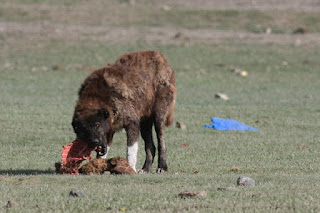Text © Tomas Axén Haraldsson, Sweden
In April 2012 me and three friends travelled in Azerbaijan for a week of birding adventure. The main source of inspiration, knowledge and help in planning was Kai Gauger and to him we owe the success of our trip. One purpose of that trip was to scout and plan for future organized group trips.
The first such trip was made 3-11 October 2013 by the Swedish bird tour
operator AviFauna with me as tour leader.
We were 16 Swedish birders accompanied by Elchin Sultanov of the AOS
and with the ground support/logistics by Caspian Tour. Our programe covered the
east of Azerbaijan, travelling within some 250km of the capital Baku, from
Greater Caucasus in the north to the coastal lagoons of Kizil Agach in the
south.
One of the highlights was Besh Barmag, the spectacular bottle-neck
migration site some 90km north of Baku. Here we spent 2 hours on October 4th
and 6 hours on October 6th in windy and cloudy conditions but with lots of
birds: a few hundred migrating raptors of 20 species including Lesser Spotted,
Steppe, Short-toed and Imperial Eagles, 12 Pallid Harriers, Rough-legged and
Long-legged Buzzard, Red-footed Falcon, Peregrine and the resident Griffon and
Black Vultures.
In the tamarisk scrubs on the beach we found Rufous Bush-chat, Green
Warbler, Desert Wheatear (3rd modern time record?), Jack Snipe, Nightjar,
Red-breasted Flycatchers, Short-eared Owl and a Richards Pipit.
 |
| Desert Wheatear at Besh Barmag 6 October © Stefan Andersson Nightjar at Besh Barmag © J-M Breider |
After wet and misty conditions in the Caucasus with no snowcocks or
other exclusive birds we were happy to see the rich bird life in the shallow
lowland lake of Haji Gaboul in eastern central Azerbaijan. An estimated 3.000
dabbling ducks and similar numbers of waders kept us busy for an afternoon.
Shoveler, Teal, Ruff and Little Stint were the bulk but we also found some some
Garganeys and a lone Ferrugineous Duck, 30 Marsh Sandpipers, 7 White-tailed
Lapwings and 1 Sociable Lapwing.
Shirvan Nationalpark was rather windy and, at times, poor in birds. The
steppes are vast but with time the list of species picked up - all four
harriers, Blue-cheeked Bee-eater, Black Francolin, hemprichii-Stonechats, a 1cy Red-footed Falcon, a flock of 300
Calandra Larks and more. The ”flamingo lake” on the other hand was thick with
birds in the open space of water visible from the hide in the reeds: Dalmatian
Pelicans, Glossy Ibises, Pygmy Cormorants, egrets and herons, Purple Swamphens,
Red-crested Pochards, Kingfishers and more wetland stuff.
 |
| Blue-cheeked Bee-eater Shirvan NP 8 October © Peter Berglin |
 |
| Spoonbills © J-M Breider |
 |
| Red-footed Falcon Shirvan NP 8 October © Peter Berglin |
The rest of the day at the northern tip of the island, around
Baliqcilar, provided nice records like Isabelline Shrike, a magnificent Saker,
many Menetriés Warblers and Red-breasted Flycatchers, Short-toed and
White-tailed Eagles and lots of more migrants.
 |
| Caspian Stonechat (Saxicola maurus hemprichii) Kizil Agach © J-M Breider |
 |
| Menetriés Warbler at Kizil Agach © J-M Breider |
 |
| Red-breasted Flycatcher at Kizil Agach 9 October © Peter Berglin |
A full trip report with photos will be published soon. Azerbaijan is
indeed an extraordinary birdwatching destination in the south-east corner of
the Western Palearctic.















































